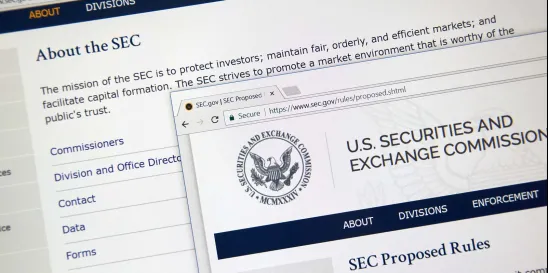The BarnBridge decentralized autonomous organization (the DAO), along with its founders, agreed to a cease-and-desist order (Order), settling charges brought by the US Securities and Exchange Commission (SEC) finding that its products were securities under federal law. This settlement is notable as it represents the first time that the SEC has formally addressed decentralized finance (DeFi) protocols and DAOs in two primary respects: (1) treating the pools issuing securities as unregistered investment companies, and (2) treating all assets held in those pools—without differentiation—as securities.
BarnBridge is a DeFi protocol that offered “SMART Yield” bonds (Bonds),1 wherein assets contributed by users were pooled in SMART Yield Pools (Pools) and loaned to third-party lending platforms to generate income for the Pools. From there, that income was then distributed to users who held Bonds. The SEC alleged that the Bonds were unregistered securities, all digital assets held by the Pools were investment securities, and the Pools were “investment companies.”
On 6 July 2023, BarnBridge publicly disclosed the existence of the SEC’s investigation and simultaneously represented that, pending the outcome of the investigation, the DAO would close its existing Pools and would not launch any new Pools—actions that were eventually confirmed by the SEC in the Order. On 22 December 2023, without admitting or denying the allegations, the DAO agreed to settle the charges, to disgorge nearly US$1.5 million of proceeds from the DAO’s sale of digital assets, and to cease and desist from committing or causing further violations, including to cease offering allegedly unregistered securities and to cease all activities with respect to associated smart contracts. The DAO’s two founders, also without admitting or denying the allegations, each agreed to pay a civil monetary penalty of US$125,000 and to cease and desist from all at-issue conduct.
THE SMART YIELD BONDS ARE UNREGISTERED SECURITIES
Relying on the test developed by the Supreme Court in Reves v. Ernst & Young, 494 U.S. 56, 64–66 (1990), the SEC found that the Bonds were notes, which is a type of security. Under the Reves “family resemblance” test, a note is presumed to be a security unless it bears a resemblance to an enumerated category of instruments already determined to not be a security. If the “note” does not bear a resemblance to any of the enumerated exempted categories of instruments, the analysis then looks to multiple factors including: (i) the motivations that would prompt a reasonable seller and buyer to enter into the transaction; (ii) the plan of distribution of the instrument; (iii) the reasonable expectations of the investing public; and (iv) whether some factor such as the existence of another regulatory scheme significantly reduces the risk of the instrument, thereby rendering application of securities laws unnecessary. The SEC found that the Bonds were “fixed income debt securities in the form of a callable note by promising a fixed or variable return based on the performance of the Pools... [and] thus constituted notes, evidenced by the deposit of principal in return for a promise to return the principal with interest.” The SEC noted the DAO promised to provide returns in its Whitepaper and on its website and that the founders used social media to promote the investment potential of the Bonds, all of which presumably supported the conclusion that the Bonds were in fact notes.
THE SMART YIELD POOLS WERE UNREGISTERED INVESTMENT COMPANIES
The SEC also found that the Pools operated by the DAO were unregistered “investment companies” under the Investment Company Act of 1940 (1940 Act). Under Section 3(a)(1)(C) of the 1940 Act, an “investment company” is any issuer that “is engaged or proposes to engage in the business of investing, reinvesting, owning, holding or trading in securities, and owns or proposes to acquire investment securities having a value exceeding [40%] of the value of such issuer’s total assets...” The SEC also found that the Pools themselves, not the DAO, are “issuer[s]” under the 1940 Act, with issuers being defined as “every person who issues or proposes to issue any security, or has outstanding any security which it has issued,” despite the Pools not being organized using a corporate structure that is more typical of registered investment companies. However, the SEC has previously deemed atypically structured actors to be registered investment companies.
If more than 40% of the assets in the Pools are securities and the Pools do not meet other exemptions for investment companies, then the Pools would be unregistered investment companies. There is otherwise no exemption for a decentralized structure under the 1940 Act, and an investment company is not required to be an incorporated entity.
The SEC stated: “[T]he only assets held in the SMART Yield Pools were investment securities, held for the purpose of generating the returns to pay SMART Yield Pool investors, and constituted more than [40%] of the value of each Pool’s total assets.” (emphasis added). However, this statement requires an analysis of what assets were in the Pools and whether they are securities—analysis that the SEC did not include in the Order.
SECURITIES CLASSIFICATION
The Order describes two categories of assets potentially managed by the Pools. The first is the digital assets loaned by investors to the Pools in exchange for the Bonds. An example provided in the Order and derived from the Whitepaper is DAI, which is a stablecoin issued by use of the Maker protocol. It is not clear from the Order whether assets loaned to the Pools only consisted of stablecoins.2 It is also not clear from the Order whether the SEC is claiming specifically that DAI or any other stablecoins are securities.
The second category of assets managed by the Pools is the “newly minted lending platform assets” contributed by the third-party lenders in exchange for the assets loaned from the Pool. The Order states that those “could be exchanged by the Pool for a return of principal and interest, and in some cases additional crypto assets that the lending platforms issued to incentivize lending.” While the Order does not describe them as such, in the DeFi world, the lending platform assets that contribute to the Pools may include assets commonly referred to as liquidity provider tokens (LP Tokens).
Accordingly, at any given time, each Pool manages both the investor loaned asset (which could include stablecoins) and LP Tokens. However, the SEC seems to be taking a broader view that stablecoins and LP Tokens are securities, without explaining its analysis in the Order. This may signal a new enforcement approach to DeFi pools.
JURISDICTIONAL APPROACH WITH RESPECT TO DAOS
The SEC alleged in the Order that the DAO took no steps to prevent US residents from purchasing Bonds, although the SEC noted that purchases only occurred through the BarnBridge website and application. This suggests that the SEC views the involvement of US residents through a website as sufficient to qualify an offering of investments to US persons. For purposes of the SEC’s analysis stated in the action, the fact that the DAO was designed to be entirely decentralized and autonomous—although in practice its two founders largely controlled most aspects of the DAO’s operations—appears to be immaterial to the securities analysis. Notably, the two founders who dominated the DAO were both located in the United States.
Individual pools in DeFi protocols (which themselves are generally mere software code) are not typically viewed as entities by the industry, much less as statutory “investment companies.” Here, however, the SEC found that the DAO, in furtherance of maintaining the Pools, “used the revenue from the [Bonds] to pay salaries to [the founders],…to pay operations teams hired and led by [the founders], to pay programming development teams, to pay for website hosting, to pay blockchain-related transaction fees, and to pay individuals involved in communications and marketing.” Indeed, the SEC found that the founders were very much involved in day-to-day operations including acting as the DAO’s “de facto executives,” overseeing “the operation of BarnBridge’s website, development of [the Pools] and hir[ing] programmers on BarnBridge’s behalf to write, test, and audit the code for SMART Yield smart contracts”, among other things. The SEC is, in effect, treating the DAO as the sponsor of the Pool, which could have given rise to claims that the DAO failed to register as an investment adviser under the Investment Advisers Act of 1940. However, the SEC declined to bring those claims against the DAO, perhaps because of the decentralized nature of the DAO itself, or perhaps because of the smart contract-driven execution.
Emphasizing this point further, Director of the Division of Enforcement for the SEC Gurbir Grewal stated in the press release that accompanied the settled order that, “[t]he use of blockchain technology for the unregistered offer and sale of structured finance products to retail investors runs afoul of the securities laws. This case serves as an important reminder that those laws apply to all who wish to access our capital markets, regardless of whether they are, or purport to be, incorporated, decentralized or autonomous.”
CONCLUSION
Although the settlement itself does not create binding legal precedent, it reveals the arguments the SEC may use against a range of participants in DeFi protocols that rely on similar pools to the Pools used by Barnbridge. The classification of pools as regulated investment companies, and separately the treatment of staked or loaned stablecoins and LP Tokens as securities, are critical considerations for all DeFi protocols moving forward.





 />i
/>i

